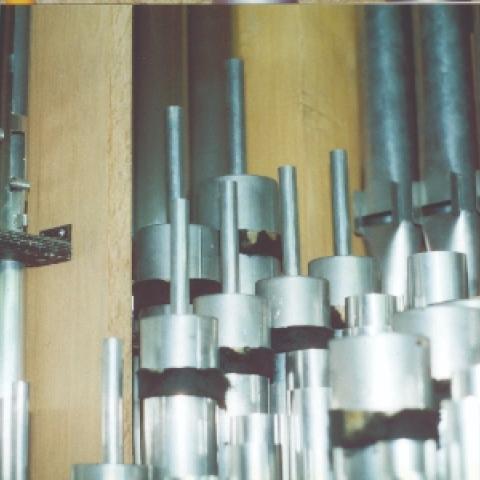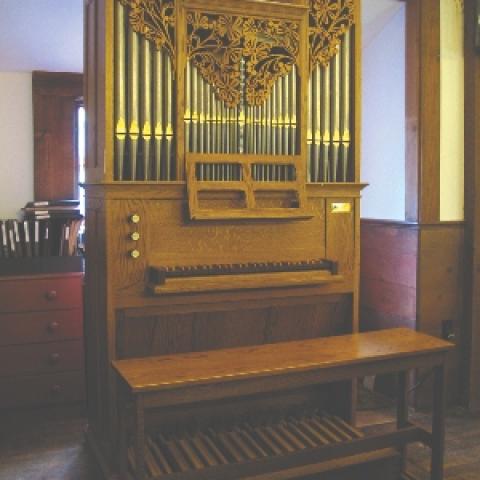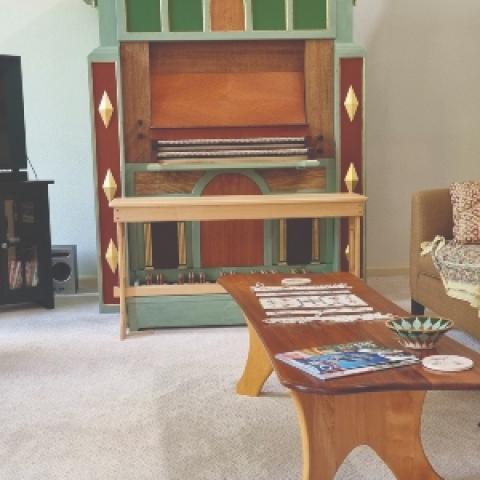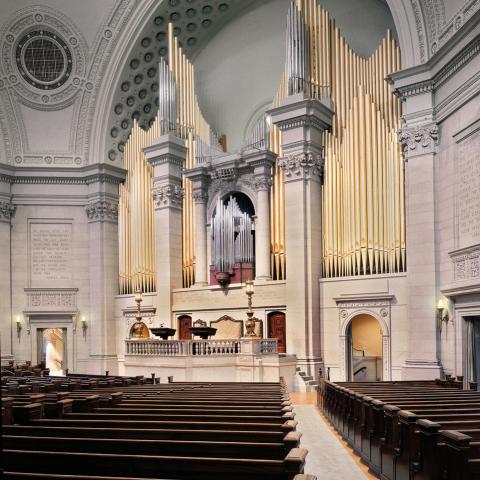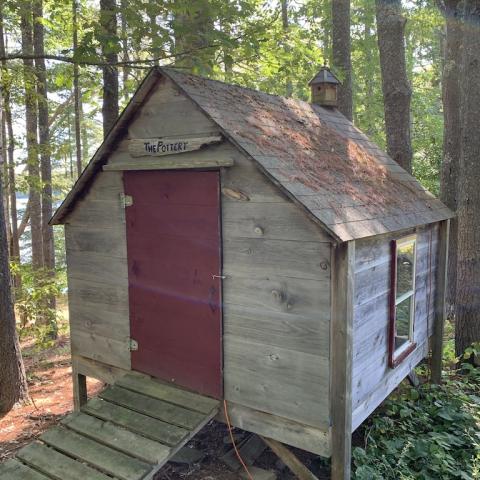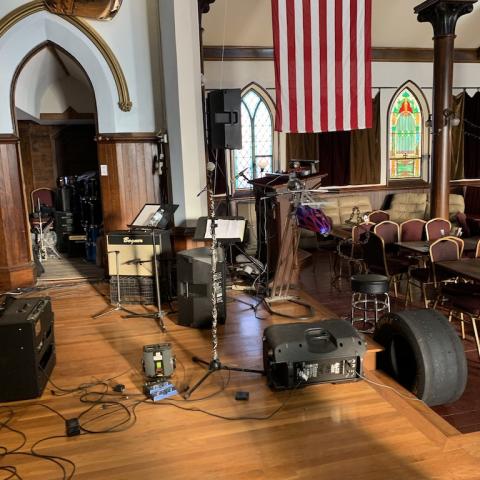
Photo: The organ that inspired back surgery, 1886 George S. Hutchings Opus 156, Korean Church of Cambridge, Massachusetts (formerly Pilgrim Congregational Church) (photo credit: John Bishop)
Rites of passage
Almost twenty years ago, I gave up the joy of serving churches as organist and director of music. I served two churches, one in Cleveland and one in suburban Boston, for over twenty-five years, concurrent with my work as an organbuilder. I was offered the opportunity to join the Organ Clearing House as director during founder Alan Laufman’s final illness. Alan passed away in November of 2000, and as I started my new job with its heavy travel schedule, I realized that I would not be able to sustain my work as a church musician. I had great experiences with semi-professional choirs in both churches and loved my role as a worship leader, especially before the retirement of the creative and supportive senior pastor in the last church. (He was followed by a fool who made it a little easier to give up the work.) It was a huge adjustment to my professional and artistic being, but it was nice to have weekends free for the first time in my life, especially as Wendy and I had just acquired our house in Maine.
I was first involved maintaining pipe organs when I started working for John Leek in Oberlin, Ohio (see this column in the February 2020 issue, pages 12–13) in 1976. Since I moved to the Boston area in 1984, I have maintained scores of organs with as many as 120 clients at one time. Since we moved to New York City five years ago, since I started a consultation business, and since the Organ Clearing House has grown ever busier, I realized last fall that I was unable to meet the needs of those clients and their organs in a timely, reliable fashion, and decided to retire from organ maintenance while continuing with the other work and while starting new ventures.
After forty-five Christmas tuning rushes, after countless arrivals at churches to find that the heat wasn’t on, after hundreds of panicky emergency calls from organists, and after one serious injury caused by a rickety antique ladder collapsing under my (admittedly excessive) weight, I look forward to a calendar free of day-at-a-time toolbox lugging, free of messy organ consoles, and free of unscheduled vacuum cleaners, lawn mowers, chattering tourists, and unannounced funerals interrupting my work.
Funny, even without all those appointments, my calendar is still filled, but it is filled with new ventures, and with the effects of Anno Domini taking their toll on my physical being, I am excited about this change. I met last fall with a couple local colleagues, asking about their willingness and ability to take on new clients, and I have just finished the last round of correspondence recommending them to the last round of my clients. I still have a lot of church keys to return, but otherwise I am officially finished. I do not want to lose my last skills (after twenty years, getting on an organ bench is not like getting back on a bicycle), so I have retained just one client here in New York. It is a synagogue that operates on a different cycle than the Christian churches, it is a large, interesting organ that is easy to get around in, there is an elevator from street level to the balcony, and it is just a couple blocks from where I get my hair cut. The organist is a good friend, and I know I will enjoy going there several times each year. It is the perfect retirement service client.
I started maintaining organs in the Boston area when I joined the shop of Angerstein & Associates in 1984, and when he closed his shop to become tonal director at M. P. Möller, I started my own business and assumed most of his service clients. I served five of those churches for thirty-six years, and in each of those, I outlasted multiple pastors, organists, custodians, secretaries, and music committee chairs.
I have written about specific experiences on the tuning road periodically in this column, so I do not need to tell you about the wedding that was delayed because there was a card table against the intake of the blower. I do not have to tell you about the time I was fired for sending a bill for almost $1,000 for a service call that took fifteen minutes. (It took six hours of driving and three hours on a ferryboat to make the round trip on Good Friday!) I do not have to tell you about the furious organist who called in the middle of a recording session saying the whole organ was out of tune, insisting that I drive two hours right away to find that high F-sharp of the Pedal Clarion was off speech. (A resourceful organist might have isolated the problem and turned off the stop.) And I do not have to tell you about the night that Madame Duruflé gave me a big hug and kiss in the midst of a post-convention recital scrum, thanking me for helping make her Boston recital a success.
But as I reflect on that long career of caring for organs, I thought I would share a few observations from the desk of an itinerant organ worker.
Upside down and backwards
The health of the church universal has diminished substantially in the last thirty-five years. As director of the Organ Clearing House, I see that more dramatically than many. Tomorrow I am visiting a huge stone Gothic building in Manhattan that was a Roman Catholic church. It once housed thousands of worshipers at a time, surrounding them in artistic glory. It is empty now. There are puddles of water on the nave floor and chains on the front doors. The immense and opulent four-manual organ is mute. We are waiting for permits to be approved so the organ can be removed.
But diminutions are visible even in churches that are functioning and relatively healthy. Earlier in my career, most churches had at least one full-time person in the office in addition to clergy. The ubiquitous parish secretary was typically the one who really knew what was going on in the place. Today, many have been replaced by answering machines, out-sourced accounting firms, and messaging through a website. It is increasingly difficult to get personally in touch with someone to ensure that the heat will be turned on before a tuning, and the pleasant banter with church staff over a cup of scorched coffee is a thing of the past.
Each church also had a sexton or custodian who cared for the building and did routine maintenance on machinery like oiling motors and changing filters. Today it is common for churches to hire cleaning services that come weekly, while volunteer members of the property committee look after the mechanical things. In my opinion, that approach is backwards, even oxymoronic. Any church building of any size has mechanical equipment like furnaces, boilers, pumps, blowers, and elevators that are much more complex and sophisticated than anything found in a usual home. It makes more sense to me to hire a stationary engineer to visit the building four times a year to service machinery and invite volunteer church members to clean the place.
Make your house fair as you are able.
Bet I just set you a’whistling, “Love, the Guest, is on the way.” My Facebook page is dotted with photos of organ consoles labeled, “. . . my office today . . . .”
True enough. An organ console is a workstation, comparable to an office cubicle or computer station. But it is also part of a musical instrument, located in a sacred and public space, and I do not think it is appropriate to keep it looking like a dirty bathroom. As a parishioner, I do not like seeing piles of books on the organ console. I know you want to keep paper clips, post-its, Kleenex, and lozenges handy, but I have always been a little offended by nail clippers, hairbrushes, paper cups, used Kleenex, and the like. I think they signal disrespect. Maybe you could use a neat little box, or a pencil case like you had in grade school. If your fingernails need to be clipped, do it at home. I do not want to hear that snipping sound from my pew. “Our Father (snip), who art in heaven (snip) . . . .”
Good console hygiene helps the reliability of the organ. Paperclips falling between keys, sticky stains from spilled soda or sugary coffee, or crumbs from that quick bagel or donut will cause sticky keys, ciphers, and dead notes. The most noticeable physical feature of the elderly female organist at one church was her waist-length gray hair. It was dramatic and lovely, until we had to fix dead notes in the pedal keyboards caused by great hairballs mixed up in the pedal contacts. Disgusting. She kept a hairbrush at the console, and I suppose she passed the time during sermons preening. I know from experience that I would rather pull recently deceased bats out of reed pipes. If you as the staff member who uses the organ do not show your respect for the value of the instrument, you are less likely to find support from funding committees when it becomes necessary to spend a lot of money on it.
During service calls and consultation visits, I make a point of observing how well a building is kept. Are trash cans emptied, kitchens clean, and floors swept and mopped? Is the choir library strewn about the choir room? Is the organ chamber and blower room full of extraneous stuff? Is the basement a repository for thirty-year-old rummage sale signs and moldy pageant costumes? All these things reflect the attitude of a parish toward its valuable real estate.
You are the steward.
You may be a famous recitalist with advanced degrees from a conservatory of music and organist of a big city church with a huge organ, or you may be a converted pianist who plays a simple instrument in a small rural church, but you are both stewards of that instrument. It is likely that no one else in the building knows as much as you do about the organ, and it is your responsibility to see that it is well cared for. You do not have to be a very sophisticated musician to notice when a note is dead, when the shutters do not work, or when the tremolo will not turn off. When the furnace stops working, a specialist is called. When the organ stops working, a specialist should be called. If you do not know anyone who services organs, ask your local chapter of the American Guild of Organists, ask your diocesan or denominational headquarters. They would be able and willing to offer guidance.
Get to know your technician. A responsible organ technician can tell a lot about how an organ is used by snooping around a little, seeing what volumes of music are on the console or in the choir room, or reading a discarded Sunday bulletin. But I always preferred to have a personal relationship with each organist. If you are confused or concerned about something, call your tuner. It is part of a technician’s job to help the musician know their instrument better, to know why and how temperature affects the pitch of the organ, to know simple facts about how to take care of it. Besides, service call chats are a great way to take the pulse of a congregation.
A responsible organ technician will keep the organist aware of larger maintenance issues that are looming. It is likely that a fifty-year-old organ with electro-pneumatic action will need to be releathered pretty soon. If the technician takes the time to show the organist what a pouch or pneumatic looks like, and how a failure of leather will affect its operation, the church in turn will be less surprised to learn that the organ will soon need hundreds of thousands of dollars of work. Even the largest and wealthiest churches need to plan ahead.
May the force be with you.
Another regular feature of my Facebook page is a meme, often featuring the dowager Lady Grantham, sneering at congregants who report that the organ is too loud. In the nearly twenty years since I “left the bench” and had opportunities to hear other organists at work, I have observed that many of them do play too loud too often. An organ that is equipped with howitzers for the glory of Easter should be played with good taste and sensitivity on Pentecost 23. I propose a courtesy tax. For each time you use the en chamade, you give up coffee for a week. It is tiring to stand through five verses of a hymn with mixtures on throughout, and it borders on offensive to have powerful reeds featured in each selection. You as the organist are used to all that power. Those in the pews are not.
The glory of the pipe organ is apparent in its quietest voices as much as in its powerful choruses. And the whole point of the instrument with its myriad voices is the palette of tone colors. As you go from one verse to another, mix it up a little. Play one verse on principals alone. Play another with the melody on an Oboe or Clarinet. Read the text of the hymn. Does it imply anything about the registration of the organ? Or do you plow through “. . . oh
still small voice of calm . . .” like a runaway train with whistles blowing?
As you are the steward of the condition of the organ, you are also the steward of its favor with the congregation. I love a powerful organ as much as the next person. I have played two hundred-rank organs in huge buildings with the high-octane brass players from a major symphony orchestra. It is thrilling. But I have also set a church full of people to weeping, including myself, as the organ shimmered gently in candlelight with an occasional punctuating note from the chimes. Make beautiful music. Do not wield a weapon.
Nothing is forever.
When I was having my first organ lessons fifty years ago, there was a vital and active community of pipe organ professionals in the Boston area. Companies like Fisk, Noack, Andover, Bozeman, and Roche were digging into the exciting world of classically inspired tracker-action organs. My mentors took me to workshop open house parties and recitals on a regular basis. Many of the concerts were followed by convivial dinners at local restaurants, and I was in the thrall of it all. The New England Conservatory of Music was a centerpiece of that activity, and it did not occur to anyone that the heady environment might be temporary.
There are still many prosperous church music programs in the Boston area, but the organ department at NEC is gone, so fewer young and brilliant organists are coming to town, and many of the churches where I serviced organs for well-known creative musicians have given up on their organs. The church that I served for so long as director of music still employs an organist, but they formally decided to stop maintaining the organ. I was stunned when I called to schedule a tuning, and the pastor got on the line to inform me.
If you share catty comments on social media when a member of the congregation suggests that the organ is too loud, if you think your parish owes you the finest organ, you are not serving the parish or the world of the pipe organ very well. This is not about you. It is about your role adding beauty, depth, and meaning to the worship of a community of faith.
When I lived in rural Ohio, a neighbor who was a soybean and corn farmer commented that a particular seed for corn was advertised as especially productive on good ground. “I can grow anything on good ground. What I need is something that grows well on my fields.”

